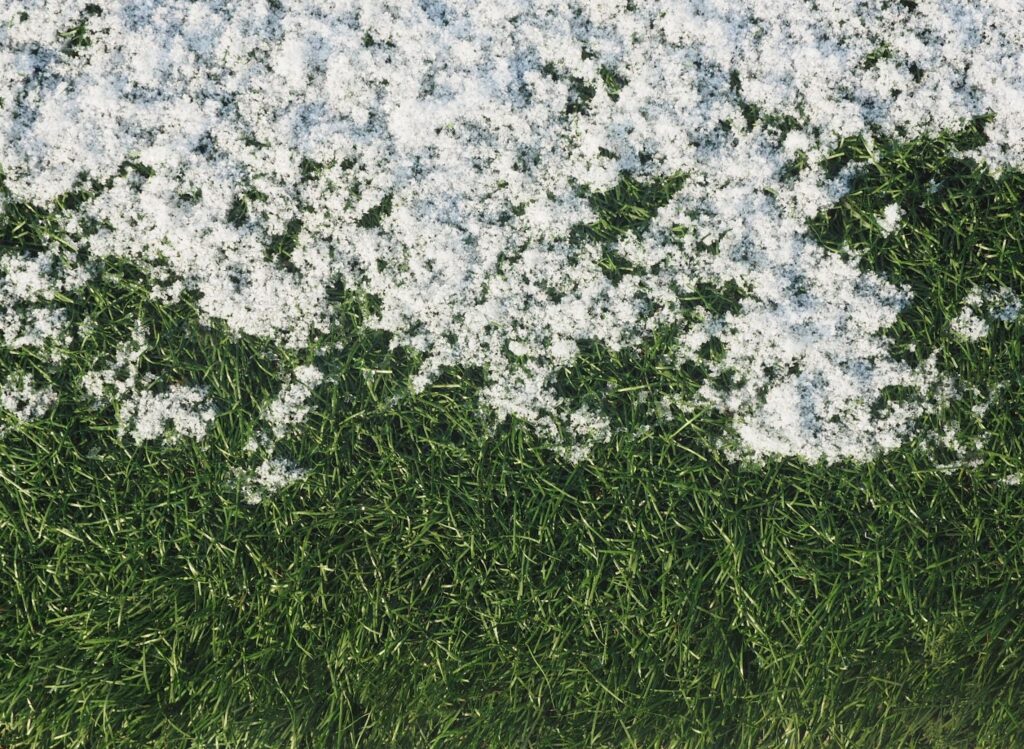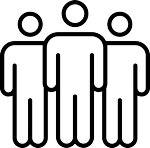As winter blankets our landscapes with its frosty touch, the care and maintenance of new sod become more crucial than ever. It’s a common misconception that sod goes completely dormant and requires no attention during these colder months. In reality, your new sod needs careful nurturing to ensure it emerges in spring as a lush, vibrant carpet of green.
Winter presents a unique set of conditions that can be tough on new sod. The cold temperatures, frost, and potential snow cover affect the health and growth of your newly laid lawn.
How to care for your new sod in wintertime involves more than occasional watering; you also need to protect it from extreme cold, manage foot traffic, and ensure it has the nutrients it needs to survive and thrive.
In this blog, we’ll share our top seven tips for winter sod care, drawing from our extensive experience and passion for lawn perfection. Whether you’re a seasoned gardener or new to lawn care, these insights will help you maintain a healthy, beautiful lawn all year round.
Tip 1: Water the soil properly
During winter, the need for watering your new sod decreases, but it doesn’t disappear. The trick is to water your sod enough to prevent the roots from drying out without over-saturating the ground. Overwatering leads to ice formation, which can damage the delicate new roots. Conversely, under-watering will leave your sod vulnerable to drying out and dying.
So, how often and how much should you water your new sod in winter? The answer varies depending on your specific climate and weather conditions. Generally, a good rule of thumb is to water your new sod once every few weeks during the winter, provided there isn’t significant rainfall or snow cover.
The amount of water should be enough to moisten the top few inches of soil. Always check the soil moisture before watering — it should be damp to the touch but not soggy.
Tip 2: Prepare and maintain the soil
Proper soil preparation is the foundation of a healthy, thriving lawn and a crucial part of sod care; it ensures your new sod has the best possible environment for root establishment and growth.
Before laying new sod, prepare the soil thoroughly.
Start by removing any debris, weeds, or old grass. The soil should be loosened and leveled to provide a smooth surface. Adding a layer of quality topsoil will improve the condition of your existing soil, especially if it’s compacted or nutrient-deficient. It’s also beneficial to conduct a soil test to determine its pH level and nutrient content.
During winter, avoid walking on your new sod as much as possible to prevent soil compaction, which hinders root growth. If your area experiences heavy snowfall, gently remove snow from the sod to prevent excessive weight and moisture on the soil. Additionally, applying a winter fertilizer formulated for new sod provides essential nutrients that are helpful for colder months.
Remember, healthy soil leads to a healthy lawn. By giving your new sod a strong start with well-prepared soil and maintaining that soil health through the winter, you’re setting the stage for a lush, vibrant lawn come spring.

Tip 3: Protect sod from frost and snow
In the heart of winter, frost and heavy snowfall pose significant threats to your new sod. Implementing the right strategies makes all the difference in ensuring your sod’s health and vitality.
When it comes to frost, try to minimize disturbance. Walking on frost-covered sod can damage the grass blades and roots, impeding growth and recovery. We recommend setting up clear pathways around your sodded areas to prevent any trampling during frosty mornings.
For heavy snowfall, gentle snow removal is key. While a blanket of snow can actually insulate your sod against extreme cold, excessive accumulation leads to issues like snow mold.
Use a plastic shovel or a broom to gently remove snow, being careful not to scrape or damage the sod. Avoid using salt or chemical deicers near your new sod, as these harm the grass and soil. Instead, opt for sand or pet-safe deicers if necessary.
In some cases, using protective covers like burlap or specialized frost blankets provides an extra layer of defense against harsh winter elements. Use these covers carefully so they don’t smother the sod. Remove them during warmer days to allow the grass to breathe.
Tip 4: Monitor foot traffic
One key aspect of winter sod care is managing foot traffic. Sod is particularly vulnerable during the colder months, so try to minimize the amount of walking on new sod. Foot traffic compacts the soil, making it difficult for roots to establish and grow, and can also damage the grass blades themselves.
To reduce the impact on your new sod, we recommend creating alternative pathways for regular foot traffic. This can be as simple as laying down stepping stones, mulch paths, or temporary walkways. These pathways will direct people away from the sod, helping to distribute weight more evenly and prevent soil compaction.
Tip 5: Fertilize and manage nutrients
Proper fertilization and nutrient management are crucial for the health of your new sod, even during winter. While your sod’s growth slows down in the colder months, it still requires essential nutrients to strengthen its roots and prepare for spring.
When fertilizing new sod in wintertime, it’s important to use a fertilizer that’s high in potassium. Potassium helps strengthen plant cells, making the grass more resilient to cold and stress. Look for a winter-specific lawn fertilizer or a product labeled suitable for new sod.
Apply the fertilizer according to the manufacturer’s instructions, typically before the first freeze. This timing allows the sod to absorb the nutrients and utilize them effectively. Be cautious not to over-fertilize, as this could harm your sod and the environment.
Remember, a well-fertilized lawn in winter sets the stage for lush, vibrant growth in the spring. By choosing the right fertilizer and applying it correctly, you’re ensuring your new sod has everything it needs to thrive.
Tip 6: Watch out for pests and diseases
While it’s a common belief that these issues take a break during the colder months, the reality is that new sod is still susceptible to certain pests and diseases during winter.
Regularly monitoring your sod will help you catch these issues early. Keep an eye out for any discoloration, thinning areas, or signs of pest activity, such as trails or chewed grass blades.
If you notice any of these signs, it’s important to identify the specific problem to apply the correct treatment. For instance, snow mold can occur under prolonged snow cover, appearing as circular patches of matted, discolored grass.
Preventive measures are your first line of defense. Ensure proper drainage to avoid waterlogged areas, which foster disease. Also, avoid piling snow on your lawn, as heavy snow sometimes creates a habitat for pests and diseases.
If you do encounter issues, there are treatment options available. Fungicides are effective for some diseases, but use these fungicides as directed and choose products safe for new sod. For pest problems, use targeted insecticides. Again, be sure to select products that won’t harm your young grass.
Remember, a little vigilance goes a long way in keeping your new sod healthy through winter. Monitoring regularly and taking prompt action when needed keeps pests and diseases at bay.

Tip 7: Prepare for spring
As winter gradually gives way to the warmer days of spring, it’s crucial to prepare your new sod for this transition. Here are some tips to ensure your new sod emerges from winter in the best possible condition, ready to flourish in spring.
Firstly, gradually increase your watering schedule as the weather begins to warm. Doing this helps awaken the sod from its winter dormancy and encourages new growth. However, be mindful of overwatering — consider spring rain when planning your watering schedule and the amount of water you’ll use.
Next, conduct a thorough inspection of your lawn. Look for any areas that may have been damaged during winter and address them promptly. Addressing these issues might involve reseeding small patches or applying a light top dressing to even out the surface.
Early spring is also an ideal time to apply a balanced fertilizer. This will replenish nutrients that may have been depleted over winter and give your sod a much-needed boost for the growing season.
Lastly, as the sod begins to grow, resume regular mowing. Make sure you don’t cut the grass too short and use a sharp blade. Doing this encourages a dense, healthy lawn and helps prevent weeds.
By following these steps, you effectively prepare your new sod for spring, setting the stage for a lush, vibrant lawn that will be the envy of the neighborhood. Remember, a little effort in winter and early spring leaves a lasting impact on the health and beauty of your sod.
Contact Monarch Sod for all your sod needs
If you need further guidance or expert services related to new sod and winter care, don’t hesitate to contact us at Monarch Sod. We sell, deliver, and install sod for private and commercial properties all along the Wasatch Front. Our team is dedicated to providing you with the best solutions and advice to ensure your lawn thrives all year round.
situs hk toto slot toto slot link slot gacor situs slot gacor situs toto toto slot toto togel toto slot situs toto situs togel bento4d login toto slot situs gacor










